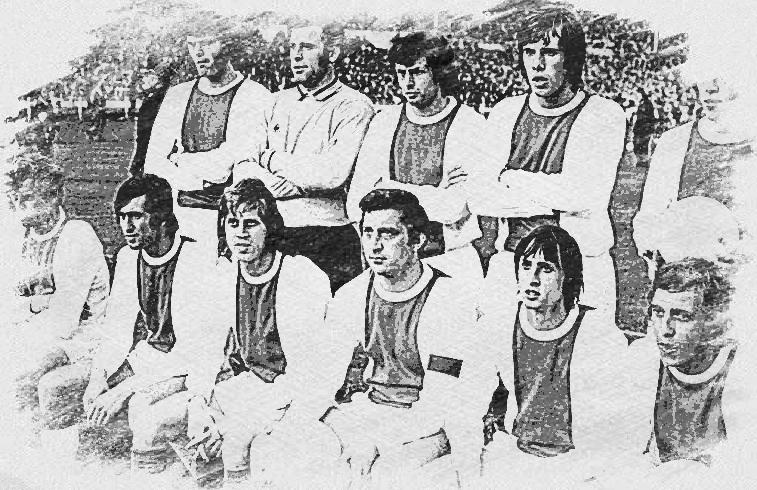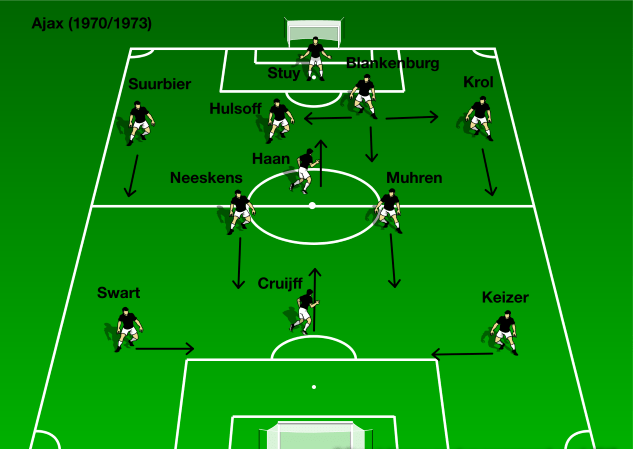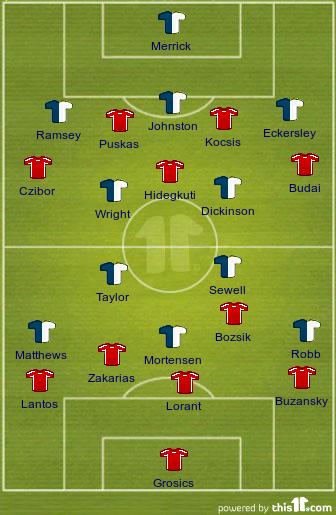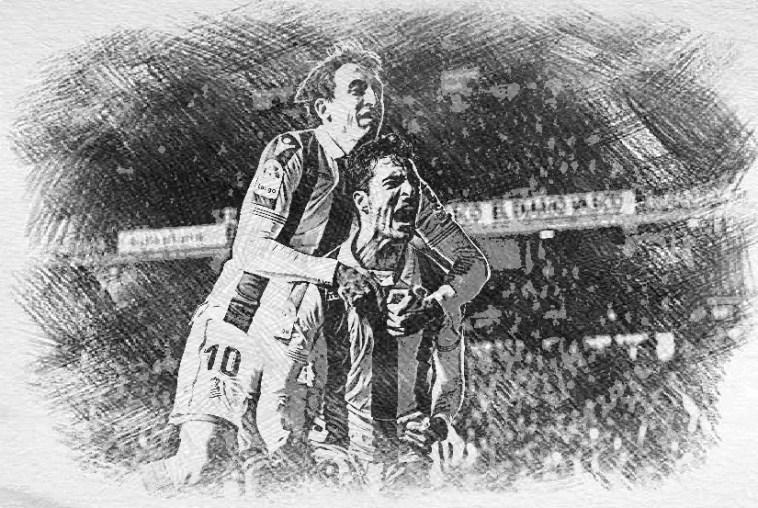
4-3-3 Role Guide: Attack and Midfield
Only a few years ago, under Arsene Wenger, Arsenal was playing some of the most attractive football in Premiership. Over the course of his long stay, the visionary Frenchman changed the club DNA significantly. The Gunners went from playing boring park-the-bus to fast-paced short passing possession game. Before Pep’s Manchester City, there was Arsenal’s elegant Tiki-Taka-style that was making waves in England. Wenger turned English football on its head with his brand of attractive football that focused on technical ability over physicality. It became known as Wengerball and was reminiscent of both early 2010s Barcelona and Ajax’ Total Football of 1970s. In the following guide I will attempt to show which roles are needed to recreate this beautiful style of football in FM20. A style that has been shown to transcend time and place.
This 1st part of the planned guide series, will look at the player roles in 4-3-3.
To quote Shakespeare, “all the world’s a stage, and all the men and women merely players”.
In other words we all have our roles to play, and everything we do is predetermined by those roles. This also happens to be very true in the context of Football Manager. In the game, players are like chess pieces who follow the directives of their preset roles. By knowing what each role if capable of, you can manipulate the rules of the game to suit your tactic. This is how I do it in my RPG (again roleplaying) Method to Tactic Creation. Reading the in-game role descriptions and understanding them brings you half-way there. Putting them together in a meaningful way is the second part. This guide will hopefully help you in piecing everything together. But first lets start by analyzing the Team Instructions in my High-Scoring 4-3-3. After we can look at the roles.
Historical Summary
Did The Dutch invent 4-3-3? No, while Rinus Michels and Johan Cruyff gave Total Football to the world, they were not the first to utilize this formation. For sure, Dutch interpretation was the most complex and effective use of the shape to this time. Yet even the concept of a False 9 was not invented in 1970s.
Total Football was unique in its use of space, position switching and heavy pressing. And while Michels first introduced this demanding style at Ajax, Valeriy Lobanovskyi pioneered a similar “gegenpressing” approach with Dynamo Kyiv. Where Michels’ approach differed was in his harnessing of the 4-3-3 formation and its innate strength in both attack and defence. But especially in how it handled possession and midfield control. The beauty of a well-played 4-3-3 is in how easy it is for very technical players to keep the ball moving between them via passing triangles. Even then in 1970s Holland, Tiki-Taka was born. And thanks to the 4-3-3, Rinus Michels was able to demonstrate the power of Total Football to the world. First with Ajax, and then again at 1974 World Cup.
Michels and Cruyff would eventually bring Dutch way of playing 4-3-3 to Spain. The Catalans have since made it their own, through a long process overseen by Johan Cruyff at Barcelona. His hard work culminated in Spain’s 2010 World Cup win. The Catalan way, dubbed Tiki-Taka, to this day has strong roots in Total Football. And it is still developing, as Pep Guardiola continues to perfect his Juego de Posición (Positional Play) at Man City.
Up to early 1970s and the rise of Ajax, 4-3-3 was a little used formation. It was not really talked about outside the circles of serious football tactics hipsters and historians. The 4-3-3 as we know it today actually evolved from 4-2-4 formation. The credit for creating the 4-2-4 should go to two different managers, on two different continents. Brazil national team coach Flavio Costa introduced a highly successful 4-2-4 system about the same time as Hungary’s Bela Guttman and his Golden Team shocked England with it at 1954 World Cup. Both Guttman’s and Costa’s tactics resembled 4-3-3 in possession phase. Hungary’s striker Nandor Hidegkuti pioneered the False9 role by dropping deep into midfield. Cruyff would late adapt this same role at Ajax.
By the 1962 World Cup, Brazil had modified its 4-2-4 system so far that it resembled 4-3-3 with forward Zagallo as its False9. England was not far behind in the 4-3-3 revolution. English manager Alf Ramsey had his own successful 4-3-3 experiment in the 1950s and 60s. He was the last coach of England to win World Cup (1966), although interestingly he used 4-4-2 for the final. So the formation seemed to evolve quickly over the 1960s and early 70s in different parts of the world. Yet it was not until Rinus Michel’ Ajax and Dutch National Team in the 1970s, that it reached its apotheosis.
Setting the Stage with Ajax-style 4-3-3
It was Ajax of the late 60s to early 70s that took 4-3-3 to a whole new level. From 1966, Rinus Michels’ Ajax team won Eredivisie six times in eight years. In 1969 it became the first Dutch team to reach the final of the European Cup (current Champions League). Then they proceeded to win this tournament 3 times in a row (1971–73). They also won the 1972 UEFA Super Cup and 1972 Intercontinental Cup.
Since then no other club has attached itself to a formation as Ajax with its 4-3-3. To this day when one mentions Ajax, the 4-3-3 (not to mention Total Football) comes to mind. Although under the numerous managers that came after Michels, club did not always play in this formation, its youth academy faithfully sticks to the well-tested formula. Ajax youth coaches make sure that the 4-3-3 is ingrained early in the Club-DNA. It’s always the first formation that the youngsters learn. And for good reasons. It is great for teaching basic tenets of tactics and formations due to its flexibility. Other than the defensive midfielder, there are no real specialists in the formation. So this gives young players the flexibility and structure to express themselves and play to the best of their abilities.
Even-though I do not foresee such whirlwind success with my own 4-3-3, my objective is nevertheless ambitious within the game. I want to create a progressive possession, attacking tactic, while playing attractive style of football. And its always a positive if we can win some trophies while doing this. That will probably be rather essential for me to keep my job, given the status of my chosen club.
Strength in Attack
One of the 4-3-3’s strengths is the ease with which it gives control over the midfield and strength in attack. This is done by means of a trio of technically gifted well-rounded midfielders. And once the midfield control is achieved, the opposition can be overwhelmed in attack. Overloads are achieved through four players who attack from the side (wingbacks and wingers). At the same time two creators (LCM and RCM) move up into halfspaces. The two key roles, the dedicated defensive midfielder and a creative forward, link everything together. Essentially, seven players could move into attack at any given time. It makes it very difficult to defend against. This is done by means of triangles which are a very effective way of out-passing and pressing the opposition.
As you can see above, the formation leaves very little space between your players. Which is a great advantage for both short-passing possession play and counter-pressing when trying to get the ball back. When it comes to playing attacking progressive possession, it’s no wonder 433 is the ideal shape. But you still need the right players, and most importantly the right roles, for the whole system to work.
False 9: Offensive Pivot
Because this formation only has one centre forward, a lot falls onto his shoulders. He is responsible for both creating chances for wide attackers and finishing some of their plays. Primarily he must be good at holding up the ball while wide attackers and midfielders make runs around him. Yet when presented with a scoring opportunity, he should not hesitate. Thus great shooting ability is always a bonus with this player. Now I am going to be devil’s advocate and suggest that my ideal False9 is a big and strong player. He should possess outstanding mental attributes to read the game well and technicals to match, such as passing and dribbling. While this combination is unique, it is not all that uncommon. Perfect choices would be players in the mold of Giroud, Dzeko, Petagna or Bruno Petkovic.
Essentially you will need a highly technical Targetman type. Someone to withstand heavy opposition pressure while his teammates move into halfspaces around him. Messi, who is diminutive and nimble, made this role famous. He is one of a kind player. But someone like him would not be my first choice unless you possess a truly worldclass player. Above all, it’s a pivot role for the whole formation and will need to be uncharacteristically self-less, complete team player.
Key Attributes:
- Technical: Dribbling, First Touch, Passing, Technique
- Mental: Bravery, Composure, Off the Ball, Teamwork, Vision
- Physical: Balance, Strength
Recommended (not essential but a bonus):
- Technical: Finishing, Long Shots
- Mental: Anticipation, Workrate
- Physical: Acceleration, Agility, Jumping Reach

Sociedad’s Willian Jose is my choice for this role. He is not worldclass but nevertheless possesses all the necessary attributes for this key offensive pivot role. Furthermore, he has two out of three essential PPMs: Comes deep for the Ball and Plays with Back to Goal. They help in bringing midfield runners and wide attackers into play. The third is Plays One-Twos which is very nice to have in any possession tactic. As you can read here, I have been a fan of one-twos since FM19.
IMPORTANT NOTE: One-Twos will only work if you have other attackers and midfielders with this trait. Basically you want the seven players who join the attack to have it. So your three forwards, two offensive midfielders and both wingbacks. I will not mention it again except that you should start teaching it as soon as possible.
Wide Forwards: Water Carriers
If the False9 is the all-important pivot then the widemen are the “water carriers” tasked with supplying and finishing plays. I set them both on Support Duty for this very reason. They can drop deep to pick up the ball and then cut inside and connect with the striker. This will often create one-twos or short passes to allow them to play through congested opposition. It helps if they are both fast and able to bring the ball inside in-spite of overwhelming opposition pressure. As such it is even better if they have great dribbling, first touch, technique, composure, workrate , agility and balance. They will help with the ball under pressure.
Key Attributes
- Technical: Dribbling, First Touch, Technique
- Mental: Composure, Off the Ball, Workrate
- Physical: Acceleration, Agility, Balance
Recommended:
- Technical: Finishing, Long Shots, Passing
- Mental: Anticipation, Teamwork, Vision
- Physical: Pace
Ideally the two should be capable of both passing and scoring, so again like the midfield, well-rounded players are ideal. But most teams, will probably have one better scorer (inside forward type) and one more creative passer. This is the setup I like to use myself so as to give more variety to my attack. So while the Personal Instructions are the same for both, they are definately not same type of player. My left winger, Isak, is the more attacking of the two. Thus his training is more focused on attacking movement in the final third. Attributes such as Finishing, Anticipation, Composure, Off the Ball, and Acceleration are the most important.
On the other hand, his right-flank partner is more of a creator/crosser. The key trainable attributes here are Crossing, Passing, First Touch, Decisions and Vision. So basically I train him like a wide playmaker.
In terms of traits, a variety can be used as long as they don’t interfere with the role’s primary functions. For instance I like both wingers to possess Run With the Ball, to take advantage of their dribbling. After-all their main job is to get the ball out wide and to bring it inside. Otherwise I will choose ones that are complementary to the specific role. So Gets Further Forward or Gets Into Opposition Area for the Inside Forward would also make sense. Likewise Placed Shots and Rounds the Keeper would make sense for a speedy technical player like Isak. On the right, I use Odegaard and Januzaj, both of whom have Likes to Pass PPM. I think it is pretty essential, especially to offset low teamwork attribute like in Januzaj’s case. And again Runs with the Ball is my other choice here.
Midfield Trio: The Needle, Recycler and Specialist
A well-balanced midfield is essential to the 4-3-3 formation. Your 4-3-3 will either succeed or fail based on your midfield trio. Here you need to place two of your most well-rounded “Total” footballers (especially in LCM and RCM slots). They need to be comfortable in both attack and defence. And to control the ball in possession and win it back as soon as it’s lost. To achieve this the two need slightly different roles that nevertheless work well in combination.
One is a box-to-box-type while the other should more offensive-minded mezzala, responsible for much of the team’s creativity in the middle. In the end both need to be creators with mezzala offering more penetration into the final third.
Mezzala – The Needle
Player tasked with the job of carrying the ball up from midfield to attackers. As a result, he needs to be a hard-working, technically gifted passer and excellent dribbler with good off the ball sense. Basically think of a typical Number 10 transported into midfield. But because of his involvement in the midfield battle, he will need to be defensively responsible. This means decent (at least two digits) level of positioning, and tackling. As a ball-carrier he should be brave, energetic, always hungry for the ball, and comfortable dribbling and passing forward on the run. On his shoulders lies the important task of carrying the ball between the lines and pushing up the field between the opposition’s players.
Roaming Playmaker – The Recycler
More of a creative box-to-box player. And essentially that is what Roaming Playmaker is in the game, a box-to-box midfielder with more risky passing. While both central midfielders should be creative-types, the Recycler should be your best playmaker of the two, with playmaker’s PPMs. Preferred Moves like Dictates Play and Switch Ball to the Other Side are a requirement, especially for taking advantage of overloads and creating chances for the inside forward. Others such as Attempts through(killer) Balls are a nice bonus.
In terms of key and recommended attributes for the Needle and Recycler, they need to be your “Total Footballers”. In other words, they require almost every attribute in the game. For this purpose Oyarzabal/Merino pair are a perfect core to build any Total Football-style tactic around. And you can check out my in-depth coverage of the two in my previous Young Devils article here.
DM(S) – The Specialist
Even-though Zubeldia is the formation’s specialist, I prefer his role to be very generic as a Defensive Midfielder on Support. Also despite the obvious emphasis on defensive responsibility, he also needs to be very well-rounded, complete player. As a holding midfielder, he sits back and covers the attacking movements of both Oyarzabal and Merino. On his part, great reading of the game is required which will translate into accurate positioning to break up the play and win back and control of the ball. Barcelona’s Sergio Busquets is the archetypal model player.
Besides Tackling, Marking and Passing, the other key attributes are mostly mental ones like Anticipation, Composure, Concentration, Decisions, Positioning, and Teamwork. By looking at Busquets FM20 profile, should give you a good idea of what king of player you will need. Trait-wise, your DM(S) will need Plays Simple Passes along with Runs with Ball Rarely. Again they are Busquet’s PPMs and play a large role in why he has been Barca’s important defensive pivot.
Tactic Update: https://ufile.io/2tdh74zf (Counter instruction should be removed as per latest version).
To Be Continued…
So hopefully this gives you a better idea of how to set up possession-focused 4-3-3. This guide was meant to be build on the introduction that I in my previous article. That article can also be found here:
If you are wondering about my role choices and instructions for the rest of the team then that part is currently in the works and hopefully will follow soon on DictateTheGame.com. Until then if you enjoy our content then please like and follow us on @ Dictate The Game’s Facebook and Dictate The Game’s Twitter












8 thoughts on “4-3-3 Role Guide: Attack and Midfield”
What’s your approach against opposition? Do you change something (mentality or team instructions) following your scout’s suggestion or do you keep your tactic always the game?
I almost never make tactical changes to adapt to opposition. I believe in playing the best way you can and forcing the opposition to adapt to you. So I’m always press, use high defensive line and split block. The goal is to have majority of possession anyway so the other teams playing style has little impact anyway. We are playing how we want in their half. And that is a lot of short passes and pressing. The only change i might make is changing the attacking width or adding be more expressive when trying to create more chances against a very defensive side.
Try an anchor man instead of the DM (S). Also look at switching out the RPM (S) for a DLP (s). Really makes the midfield click. So MEZ-A for Iniesta, DLP (S) for Xavi, and A (D) for Busquets.
Hi, I answered your question on the sigames forum here: https://community.sigames.com/topic/486484-everything-total-football-from-cruyff-false-9s-4-3-3-to-guardiolas-overloads-updated-march-2020/page/3/#comments
Hi there pal. What a tactic. My favorite way of playing. love it. Thank you. do i remove both counter press and counter instruction?.
Hi. Now i keep counterpress against most sides. Except against the top teams I remove it. I removed Counter.
That’s an interesting tactic. Although I think might be complicated to use it. Demands a lot physically of some players